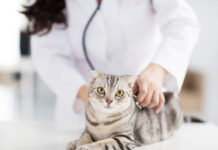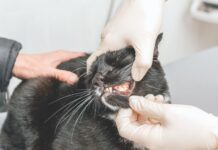I just had my annual physical examination and, of course, the nurse checked my blood pressure. Coincidentally, my cat had her annual exam the day before, but her blood pressure wasnt checked. In fact, it never has been checked. Why doesnt my veterinarian check her blood pressure? Dont cats have problems with hypertension like people do?
Our understanding of hypertension in cats is still in its infancy, but with newer methods of measuring blood pressure and a heightening concern among those studying the condition, Im sure well learn much more as time passes. Even now, we know that cats indeed experience problems associated with hypertension. High blood pressure seriously affects the health of the kidneys, brain (causing seizures, disorientation and more), heart (causing heart enlargement and abnormal heart rhythms), eyes (causing sudden blindness), and other organs. But accurately measuring a cats blood pressure and interpreting what the measurements mean present some major challenges.
Excitable little critters
A cats blood pressure normally rises dramatically in situations it deems stressful – like a trip to the veterinarian. Even we humans can find a visit to the doctor pretty disconcerting. The term white coat syndrome was coined to describe the reason our blood pressure goes up in a doctors office. Thats why our doctors will usually repeat the measurement several times in the office if it seems a little high – they can get more accurate readings after we calm down a bit.
If the result is still in doubt after a few tries, they may recommend that we check it at home multiple times daily for several weeks with a portable measuring unit-again in an attempt to get accurate measurements when were relaxed. Cats undergo the white coat syndrome. (Imagine dilated pupils, tense muscles and a rapid heart rate.) When cats are excited, their blood-pressure increases make ours pale by comparison. Theres not yet a firm agreement about when a cats pressure is too high, but most agree that a systolic pressure (thats the top number in a blood-pressure reading; yours should be about 120) exceeding 150-170 mm Hg is abnormal in a relaxed cat.
Measuring blood pressure in cats takes special equipment and skill. The units physicians routinely use to measure our blood pressure wont work in cats, and only recently are veterinarians reaching agreement about which devices are most suitable in a clinical setting. (It seems that Doppler flow detectors are winning in the opinion polls.) But even with the proper equipment, it takes a lot of practice, time, patience and experience to measure cats blood pressures accurately. To obtain the most reliable results, pressure measurements should be taken in a quiet room away from other animals and activity. Its best to let the kitty relax for at least ten minutes before embarking. An experienced technician will gently and consistently take several measurements over the course of anywhere from half an hour to 45 minutes.
So, what cats should be measured?
Primary, or essential, hypertension – the most common form of high blood pressure in people-appears to be rare in cats. This, along with the difficulties noted above, is the reason most veterinarians avoid routinely measuring pressure in young, normal cats.
But hypertension is a common consequence of other feline diseases, and it can have devastating results. Kidney disease is probably the leading underlying disorder, but other conditions, including hyperthyroidism and diabetes mellitus, can cause it as well.
Although obesity is a major risk factor for hypertension in humans, its not known whether this growing problem (sorry for the bad pun) is a risk factor for felines. An increasing number of veterinarians are rightly recommending checking the blood pressure of feline patients suffering from diseases known to be associated with hypertension. (In spite of the caveats, some veterinarians routinely screen all senior cats even in the absence of these conditions, but being very careful about interpreting the results.)
Treating the underlying disease is a major step in resolving feline hypertension, but sometimes the high blood pressure itself must be attended to. Veterinarians have a growing number of anti-hypertensive medications in their arsenal (e.g., angiotensin-converting enzyme inhibitors, beta blockers, calcium channel blockers, and diuretics) and there will likely be some trial-and-error involved before the right therapy can be found for any particular cat. Dietary sodium restriction alone is usually ineffective – plus, cats hate the way reduced sodium diets taste – but its sometimes tried along with medication. In spite of the extra effort involved, Im convinced that treating hypertension in addition the underlying disease will lead to a much more favorable outcome than if only the primary condition is addressed.



